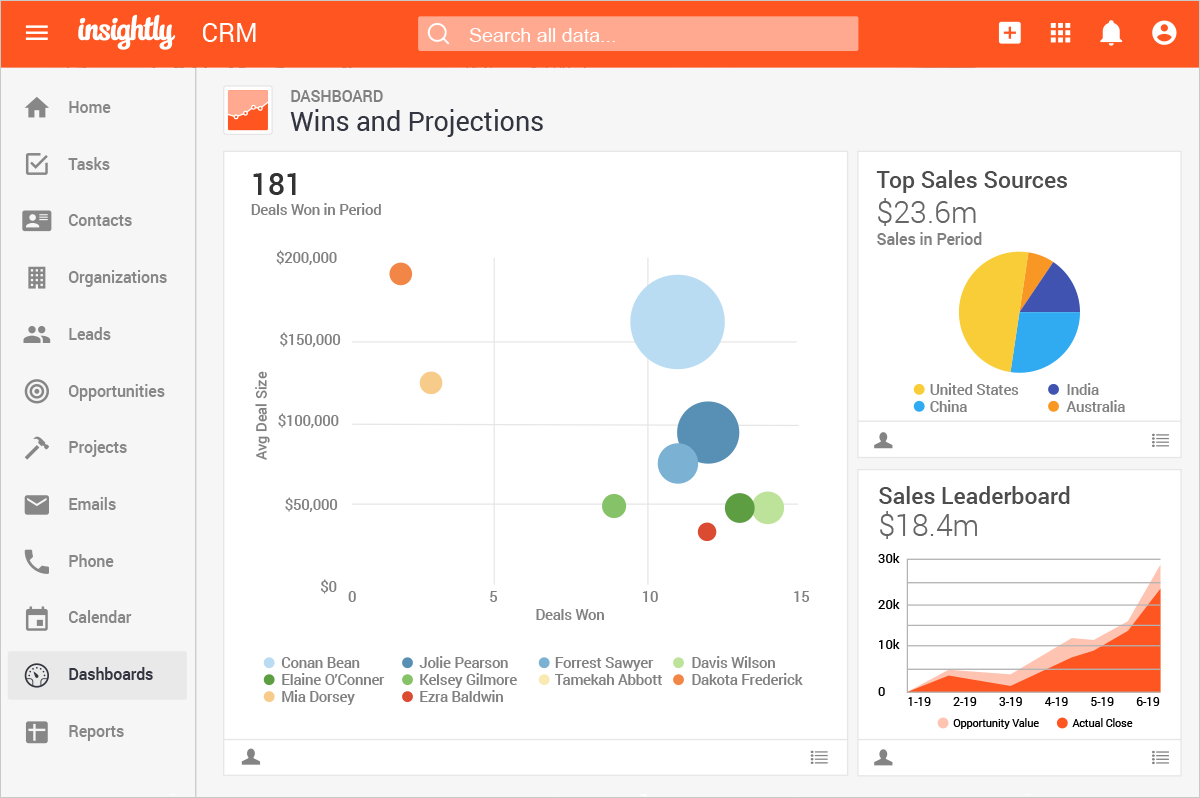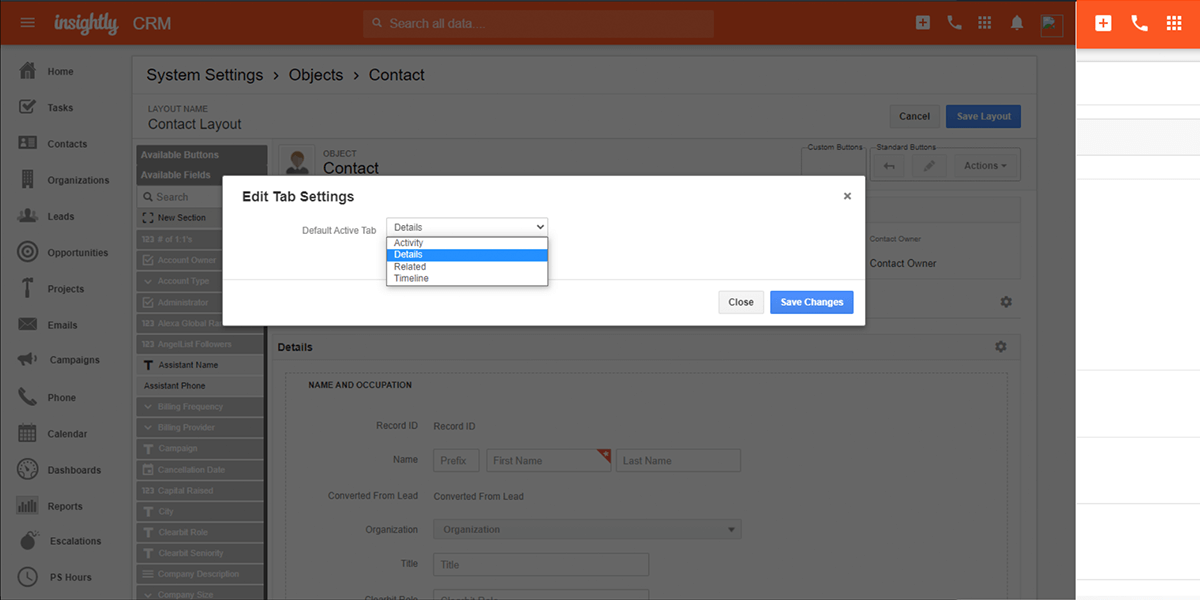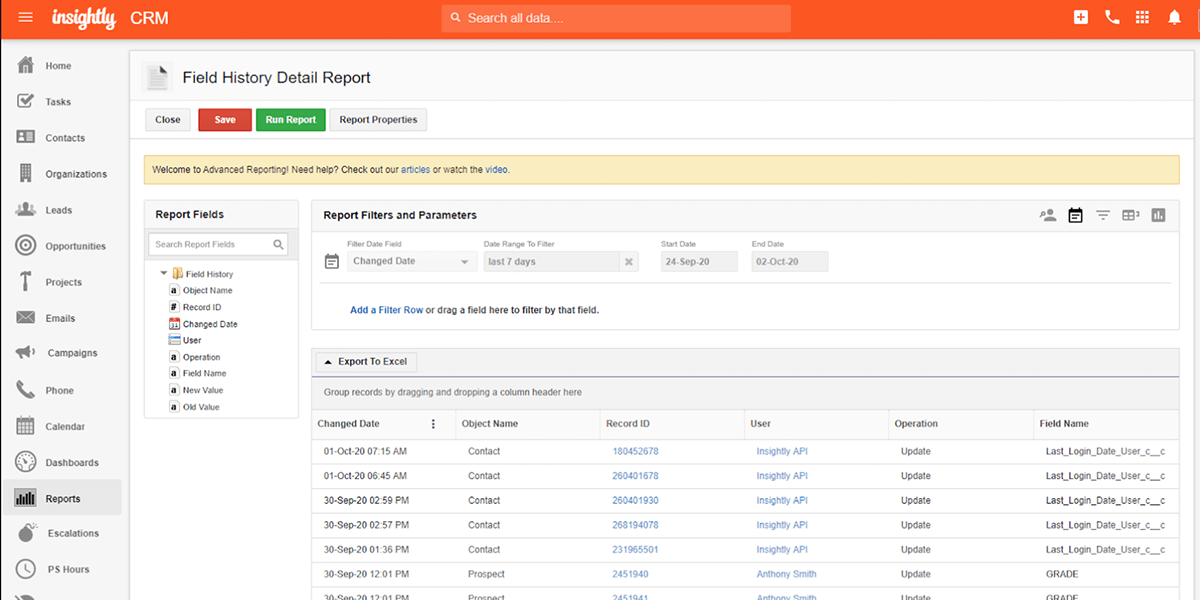The post 2022 Midpoint: Solving the Top 5 B2B Sales Challenges appeared first on Insightly.
]]>Today’s sales organizations are facing challenges unlike any they’ve seen before—but the most successful teams have always been flexible, agile, and adaptable. The key lies in recognizing potential pitfalls and finding smart ways to overcome them.
As we move to the midpoint of 2022, we’ve compiled this list of top sales challenges for 2022, along with tips and recommendations for navigating them successfully.
Challenge #1: The Great Resignation
According to the US Bureau of Labor Statistics, nearly 48 million people voluntarily left their jobs in 2021. This unprecedented exodus from the workforce—dubbed “the Great Resignation”—has hit sales teams especially hard, with average turnover rates estimated around 35 percent.
Even in the best of times, attrition makes it difficult for sales teams to operate effectively. Sales leaders are forced to focus on hiring and onboarding instead of strategy and execution. Performance suffers as depleted teams struggle to meet revenue goals. And morale declines as those who remain are left to pick up the slack. The best way to protect your team—and the bottom line—is by retaining the employees you already have.
How to manage it
Here are some tips to increase retention and minimize the impact of the Great Resignation:
- Show your appreciation. This should be obvious, but employees are less likely to leave when they feel valued. Take the time to recognize accomplishments and celebrate milestones. Invest in sales training and provide opportunities for career growth. Most importantly, treat each person as an individual—not just a cog in the sales machine.
- Clarify your employer value proposition. Of course your comp plan should be competitive, but retaining your sales talent is about more than money. Give them something to believe in! Develop clear messaging about your company’s culture, your mission, and your products—and show how you’re making a difference in the world. (This is especially important for Millennials.)
- Uncover the real problems. Despite your best efforts, some people will inevitably choose to leave. As painful as they may be, exit interviews are your best opportunity to discover the issues that are driving talent away, so don’t treat them as a formality.
Challenge #2: Coming out of “pandemic mode”

As we emerge from more than two years of pandemic-induced uncertainty, sales teams everywhere are struggling with the questions of a new reality. Live events are starting to return, but will they ever be the same? How do sales meetings work when my prospects work remotely? Are the virtual processes we put in place on-the-fly appropriate for the long term?
The fact is, the Covid-19 pandemic forced businesses to innovate, and some of those innovations are more efficient and effective than the old way of doing things. Rather than waiting for a return to “normal,” smart sales teams are seeking a way forward—which requires a creative, hybrid approach that blends digital channels with traditional in-person interactions.
How to make it work for you
As you prepare your team for post-pandemic selling, here are a few recommendations:
- Learn how to work virtual events. In-person conferences are making a comeback, but virtual events are likely here to stay. Without a traditional booth to make connections and book meetings, you’ll need to get creative with your event strategy. Every virtual event is different, so investigate the event platform and agenda to identify the best networking opportunities. Then get involved with the event itself. Attend as many sessions as possible and participate in sidebar chats to make organic connections.
- Adjust tactics for digital leads. A greater percentage of leads are likely to come from digital sources (rather than trade shows), so you may need to fine-tune your nurture tactics to move them through the funnel. Email remains a go-to channel for sales communications, but consider adding a personalized video to build rapport without face-to-face contact.
- Invest in training. Now more than ever, sales is an evolving field. A proactive approach to training will keep your team up-to-speed on emerging skills that can help them sell in a virtual-first world. Regular training also keeps everyone aligned and ensures you’re all working toward the same business goals.
Challenge #3: Gen X buyers take the reins

We’ve touched on the Great Resignation, but there’s another employment phenomenon that’s impacting sales teams: the Great Retirement. The Baby Boomers (currently 58-76 years old) are retiring in droves, and the Covid-19 pandemic only accelerated their employment exodus. As of late 2020, nearly 30 million Baby Boomers had retired—and a year later, more than half of adults age 55+ had joined them.
As Baby Boomers vacate long-held leadership roles, a new and different cohort is taking control of B2B buying decisions. Generation X is a much smaller population than either Baby Boomers or Millennials—so they’re frequently overlooked—but understanding the nuances of “Gen X” is now critical to selling success.
How to embrace it
As you navigate this new generation of B2B buyers, here are a few things to keep in mind:
- Gen X values authenticity. Unlike Baby Boomers who don’t mind being “sold,” Gen X buyers value marketing that is personal and authentic. Earn their business by becoming a trusted advisor. Your sales messaging should demonstrate how you can help them achieve a specific business result, like saving money or avoiding risk.
- Gen X questions everything. As the original “latchkey kids,” Gen Xers were often left to fend for themselves, and major economic events like the dot-com bust shaped their formative years. As a result, Gen X buyers tend to be independent thinkers who value data and unbiased research. They want the straight, unvarnished truth—and they want to see the proof, not just the pitch.
- Gen X is tech savvy. Born between 1965 and 1980, Gen Xers have spent their lives adapting to new technology. While they aren’t digital natives, they’re comfortable with a wide variety of digital channels and tech platforms. But they’re also a nostalgic group, so the occasional direct mail campaign may land well—if it’s authentic and well executed.
- Gen X has unique communication preferences. While Gen Xers are often stereotyped as loners, the isolation of the pandemic affected Gen X buyers just as much as everyone else—so they’re likely ready for some face-to-face contact. Their feelings on phone calls are somewhat ambivalent—they’re more likely to answer than Millennials, but far less likely than Boomers.
Challenge #4: Remote work limits expansion opportunities
“Land and expand” is a popular sales strategy—and with good reason. Starting small and building on that foundational relationship lets you earn more business and land bigger deals throughout an organization. Studies show that 84% of B2B buyers start the purchasing process with a referral, and peer recommendations influence more than 90% of B2B buying decisions.
Of course, expansion becomes more difficult in a remote workplace because your customers aren’t having those everyday water cooler conversations. That means you’ll have to get creative—and proactive—if you want to connect with internal decision-makers.
How to overcome it
Following are some ideas to help jumpstart your expansion efforts:
- Do your homework. Develop a clear value proposition to explain how your solution can help different parts of the prospect organization. The selling points that resonated with your initial contact may not have the same impact in another department.
- Use all the tools at your disposal. Tools like LinkedIn and ZoomInfo make it easy to identify additional prospects within an organization. Your CRM data can also provide extensive insights on the people who make purchase decisions at your target company.
- Be proactive with outreach. If you have a solid relationship with a contact, ask for referrals. Requesting introductions to specific people is usually more effective than a blanket referral request—which makes your prospecting research even more important.
Challenge #5: Lack of alignment between sales, marketing, and success teams

Internal alignment isn’t a new challenge, but it’s even more common among remote teams. In many organizations, the tools to enable remote work were selected hastily and implemented haphazardly, leading to poor integrations and siloed communications. And remote teams tend to communicate less overall, which creates more opportunities for misunderstandings and conflicting priorities.
Misalignment has significant consequences, including tension between teams, poor customer experience, and missed revenue targets. So it’s in everyone’s best interest to give sales, marketing, and success teams the tools and support they need to work together effectively.
How to fix it
Here are some tips to help you build (or rebuild) alignment between internal teams:
- Leverage technology to improve communication. Real-time chat tools like Slack, Google Chat, and MS Teams can go a long way toward replicating face-to-face conversations. Because they’re so easy, they encourage more frequent and informal communications.
- Schedule recurring meetings. Regular sales team meetings are a must, but you should also schedule monthly or quarterly meetings with marketing and support teams. Meet in person when you can or use video conferencing to increase engagement on remote calls.
- Get on the same platform. Giving everyone access to the same data is a huge step toward improving alignment. A unified CRM platform (like Insightly) serves as a single source of truth, to give cross-functional teams a 360-degree view of each customer.
- Optimize integrations. When evaluating your tech stack, consider the tools your team already uses. Any new additions should integrate easily with the tools your team relies on, to increase adoption and utilization.
Meet your toughest sales challenges head-on with Insightly
At the end of the day, the solution to most sales challenges boils down to three things: consistent processes, internal alignment, and deep customer insights. The right CRM puts these goals—and more—within reach.
Insightly CRM was designed to help growing teams develop and manage customer relationships through a simple, scalable platform. Insightly is the only solution that aligns sales, marketing, and services on a single, shared data platform for unprecedented transparency and a seamless end-to-end customer experience. And with its intuitive user interface, Insightly CRM puts customer insights at your fingertips for more strategic decisions and better business outcomes.
Get started with a free trial of Insightly CRM today, or request a personalized demo to see how it can help your company achieve its business goals.
The post 2022 Midpoint: Solving the Top 5 B2B Sales Challenges appeared first on Insightly.
]]>The post The 4 types of CRMs and their differences appeared first on Insightly.
]]>A Customer Relationship Management system (CRM) is a tool to manage all of your organization’s relationships and interactions with customers and potential customers. CRMs provide a firsthand understanding of your customer’s experience to help you match your products and services to their needs.
Like any tool, you’ll get the most out of your CRM when you put the most into it. The first step in that effort is to be sure to choose the best CRM based on your needs.
If you’re unfamiliar with the CRM software market, you may feel overwhelmed. In short, it’s huge.You may not know that there are subsets of CRMs, so it’s important to align your business type and objectives with the right offering. Let’s begin with what is generally agreed to be the four classic types of CRM systems.
Type 1: Operational CRMs
Operational CRMs provide customer service or marketing support through automation and streamlining business processes. They capture customer interactions and track lead qualification and action marketing automation.
Operational CRMs collect data from different marketing sources like social media, emails, or website visitors. This data can help your marketing team quickly and easily qualify leads. Operational CRMs also add value by providing more upfront information for analysis. An example of an operational CRM is Spotio.
Type 2: Analytical CRMs
Analytical CRMs use algorithms and machine learning to analyze the data they gather to create optimal customer targeting. Analytical CRMs provide insight into data and then understand and anticipate the customer’s needs that humans would otherwise miss.
This category of CRM provides higher levels of insight and analysis regarding customer data. In addition, you can customize and scale them to allow your business to add or remove modules to suit your needs. An example of an analytical CRM is OLAP.
Type 3: Collaborative CRMs
Collaborative CRMs are mainly for customer relationship management tracking. These CRM solutions allow you to manage and track interactions with customers who contact your company via resources like social media, emails, and websites. A tracking system can help your team share sales process and task status information, reducing the confusion on what they need to do next. An example of a collaborative CRM is Dynamics 365 Sales.
Type 4: Strategic CRMs
Business models that focus on repeat and loyal customer bases use strategic CRMs to learn more about their customers. They then use this knowledge to build and maintain long-term relationships.
Like the other types, strategic CRMs collect, analyze, segregate, and apply customer information and market trends to develop better value propositions. The difference is, this type of CRM uses algorithmic and analytical features to focus on building loyalty. It also finds strategic opportunities for engagement consistently and for more extended periods. Most generic CRMs would be identified in this category.
Legacy CRM: Salesforce
Salesforce is the grandfather of sales CRMs. It is practically a household word these days, but it is also famous for being highly complex and expensive to deploy.
Salesforce setup is time-consuming. The system’s complexity will require specialized resources that are almost always unavailable internally. Also, it may leave you with limited options. Although Salesforce claims to be integrated, additional apps are more bolt-ons than enhancements.
Salesforce uses its market dominance to lock you into a single CRM type. A single type of CRM means you will be stuck with a solution that will evolve slowly. That leaves you with a problematic tool to use and constricts you to its technology.
One of its main drawbacks is its high initial price point and recurring costs. The pricing structure is as confusing as it is costly. Development and user interfaces can be tricky to use. There are steep learning curves and user adoption issues that both admins and end-users need to surpass to get the most out of it. This makes the total cost of ownership very high.
The major advantage to Salesforce is also its major drawback: it’s a popular solution so theoretically you can hire people who already have experience in using it. However, it’s so highly customized by each organization that going from one Salesforce instance to another is akin to starting over.
Niche player CRM: HubSpot
HubSpot’s primary focus is on marketing and marketing automation; its CRM came later.
HubSpot is often perceived as a closed system that does best when it is not subject to integrations. As an example, companies with multiple and intricate sales technologies may not find it easy to integrate their complex environment with non-HubSpot technologies.
A common concern about HubSpot is that it lacks flexibility and robustness when it comes to customizations and sales reporting. When identifying duplicate accounts and contacts, data synchronization is another example of its inflexibility.
Also, keep in mind that if your business or organization is in growth mode, it’s likely that you will outgrow HubSpot at some point. Thus the process of selecting and implementing a new CRM will be on the horizon for you again.

How to choose the right type of CRM
While classic one-type CRMs noted above perform well within their strength areas, they can get you and your team stuck in a data silo. Whether it’s technological, price, or people-based, sooner or later, you’ll end up with a solution that doesn’t meet your needs.
Legacy and niche solutions come with their own set of problems, including the risk of difficult user adoption, counter-intuitive UX, costly time, and investment losses due to additional customizations.
You know you need to choose a CRM that will grow with your business, integrate easily, and not break the bank. It’s time to explore a modern, unified CRM as the answer to this need.

Why modern unified CRMs are the answer
Modern CRMs save you time and money because they are easy to set up, so you don’t have to engage with expensive integrators to implement your CRM. Implementation is quick, so you won’t need to wait months to experience the benefits of your new system.
The six main reasons to choose a modern unified CRM are as follows:
1. Improved collaboration and automation – Modern CRMs like Insightly ensure that your sales, marketing, and customer support teams find and work on the information they need. Winning a customer’s business and loyalty takes a united effort, not a siloed one. With modern CRMs, you can give your teams the ability to work in a united and carefully tracked manner due to the enhanced collaboration and automation.
2. Maximized marketing automation – Most marketing teams juggle multiple tasks and projects at the same time. Marketing automation can allow you to maximize your marketing team’s time and effort. For example, by using Insightly Marketing, your team can create and recreate campaign structures quickly instead of having to reinvent the wheel. In addition, they can rapidly deploy workflow-based processes like web-to-lead forms that automatically generate new records and update data fields to ensure proper categorization. Easy-to-create workflows can trigger drip campaign emails that keep prospects highly engaged. Marketing reporting is easy as well, and is visible to all other teams.
3. Streamlined sales automation – Unnecessary data entry means sales teams waste time and energy instead of concentrating on deals and the pipeline. Modern CRM sales automation can streamline sales aspects such as lead nurturing and routing. Insightly Sales makes lead-building email outreach campaigns easy for your team to manage. New leads receive emails automatically within moments of requesting information. All additional emails will seamlessly go out throughout the buyer’s journey without creating new manual task bottlenecks that are inefficient and prone to error.

4. Concise customer service automation – Closing new business is the goal, and it’s just the beginning. There’s so much more work to do to communicate the needed handoffs to deliver on promises and serve the customer. It’s vital to get these tasks right so you can retain your newly-won customers. Insightly Service, which is built on the same platform as Insightly CRM and Marketing, includes key features like an easy-to-access blade showing knowledge sidebar, macros, and full history, making it easy to share information and communicate quickly. It also includes quick visibility to SLAs, so reps can stay on track. Convenient dashboards and reports help managers analyze workflows and deploy resources more efficiently.
5. Deeply integrated – Modern CRMs like Insightly are more agile than legacy CRMs because they allow you to quickly build sophisticated integrations with the applications you already use in your organization, like Google, SAP, DocuSign, and much more. Imagine building workflows and integrations without writing a line of code. Insightly’s AppConnect is a no-code solution, so you don’t have to hire developers. AppConnect uses drag and drop functionality, automated error handling, built-in versioning, plus instant deployment and provisioning so your team can build and run sophisticated integrations efficiently.
6. Easy to implement and onboard new people – Legacy CRMs are complex and challenging to implement. They require a deep knowledge of the technology and often require third-party consultants to help, and that’s just with the install. The extreme amounts of documentation and training options demonstrate the complexity in deploying and rolling out to end-users. Modern CRMs like Insightly are built with the user experience in mind. They are designed to be intuitive and to perform like common consumer apps that are already familiar to users. They eliminate the need for long and complex implementations and get your team up and running as quickly as possible so you can experience CRM success in no time.
Where to start?
Not sure where to start? Get your personalized demo of a modern, unified CRM today to see it in action.
The post The 4 types of CRMs and their differences appeared first on Insightly.
]]>The post CRM integration: What it is, why is it essential, and 4 key integrations appeared first on Insightly.
]]>Customer Relationship Management (CRM) integration is essential to unlocking the true power of a CRM. Integrations add functionality to CRMs and build a reliable source of truth you can count on to make decisions across your entire organization by connecting every single application you use to run your business.
When done right, CRM integrations reduce organizational silos, save time, and bring an in-depth customer understanding to your entire organization.
This clarity is where the CRM magic happens.

What is CRM integration?
A CRM is mission-critical sales technology that guides and manages interactions with current and potential customers. It helps companies build relationships with their target audience to improve the customer experience, increase sales and improve profit margins.
Given this definition, it’s easy to see why your CRM must be integrated with the rest of your tech stack. CRM integration allows customer information to flow freely between all the applications you use to run your business. It’s a 360-degree view of customer data since your data synchronizes across all systems.
CRM integration creates an accurate, comprehensive picture of your customers and prospects. It improves how you communicate with customers, delivering more value from every interaction.

Why integrate your CRM with other tools?
Sure, you can run your CRM without integrating it with your other systems, but you’ll be missing out on a host of benefits. When you integrate your CRM, you can expect to experience the following:
- Increased customer interaction: Delivering solid customer support should be at the top of your list to guarantee customer satisfaction. Sharing data quickly among platforms gives an up-to-the minute view of data across your business, empowering your team to serve.
- Reduced manual processes: Manually transferring data from apps to spreadsheets is labor-intensive and error-prone, and keeps businesses from maximizing their human resources. Plus, manual processes are more prone to errors, leading to a potential decrease in accuracy and, in turn, customer satisfaction.
- Improved reporting: When data across systems is shared, you get an end-to-end view of your organization which empowers your team and your leaders to make better, more informed decisions.
Additional benefits include:
- A complete view of your customers for all users
- Improved, long lasting customer relationships
- An overall increase in sales velocity
The no-code/low-code approach
So, you’re convinced that integrating your CRM is the right move. You may now be wondering how expensive and time consuming that is going to be. The answer depends upon the type of CRM you have implemented. It’s true that some CRMs will require you to work with an outside firm, require developers to write code, and it will a long time to enable your requests.
However, if you’ve selected a modern, unified CRM like Insightly, the process looks much different. Insightly’s AppConnect is a dynamic and easy-to-use, no-code integration engine. It lets you build sophisticated integrations and workflows between Insightly and hundreds of applications you use across your entire organization.
Using AppConnect, Insightly facilitates CRM integration without long development cycles. The best part is that you don’t have to be a software engineer to build integrations in your CRM system due to the intuitive, user-friendly interface. So if you’re already using Slack, GSuite, NetSuite, Oracle, or any of hundreds of other platforms, AppConnect is ready to help.

4 Essential CRM integrations for functional teams
Now you know that CRM integrations allow your team to maximize and optimize tasks and perform their jobs more effectively. The more you can integrate CRM technology with your teams and their workflows, the better you’ll be able to focus on what counts — your customers’ experience and their goals.
You likely want all of the integrations right now, but how do you decide which to prioritize? Talk with your teams to discover and understand their frequent and high visibility needs to gain momentum when kicking off enhancement projects. This approach will simplify processes and provide a clear roadmap to help you determine and prioritize what integrations will deliver the best ROI and limit scope creep during the building sessions. The good news is that Insightly AppConnect is so easy to use, that you can tackle many integrations right away.
Finance and accounting
Empowering your team by integrating their SAP, Quickbooks, and DocuSign processes into a CRM can free them from unproductive platform toggling. They can automate the entire end-to-end process and securely sync and store vital vendor and organizational data, too.
Frequently used requests or processes (payment, invoicing, ordering, quoting, etc.) can be triggered and routed automatically to and from platforms like SAP and Quickbooks that record each step’s signing-off (DocuSign) status and history. CRM integrations also allow you to make sure all needed and required compliance documents are automatically uploaded and organized proactively, so you don’t have to put in the effort to meet regulatory filing and audit checkpoints.
Using integrated dashboards, you will never be far away from reporting status. All your spend and revenue data is ready and at your fingertips to provide critical insights and empower agile business decisions in real-time.

Human resources
Hiring great talent can be a challenge. With integrations to Talent Management platforms like Greenhouse, you can automate referrals and recruitment processes like scheduling interviews, and manage interview feedback communications effortlessly.
Enhanced integrations can also help save HR staff time by keeping job descriptions up-to-date, improving resume scoring, and surfacing better candidate choices, all while syncing it with your HR solutions and platforms.
It can take a considerable amount of time to hire someone, and you want to get them onboarded and productive as fast as possible. Integrating apps like BambooHR, Workday, and OKTA can automate onboarding and offboarding sequences for account generation or deletion, and grant permissions, benefits selection, and HR-based equipment provisioning.
IT and operations
Any downtime means a loss to the bottom line. IT integrations can help detect problems and proactively initiate incident resolution processes. Integrating your CRM with platforms like ServiceNow can automate and prioritize incident ticket generation, which will help decrease resolution times. Users can stay up to date with real-time communications via chatbots and collaboration tools like Slack. This can serve to communicate status in areas like ticket escalation, ticket assignments, and incident alerts. Help Desk staff can access best-practice knowledge libraries from multiple systems, so they have one source of truth when researching solutions.

Sales and marketing
When marketing and sales are in sync, the odds of success dramatically increase. Teams can elevate and strengthen marketing and sales impact by integrating a number of applications to help support and enhance collaboration. Some examples include:
- Keep lines of communication open with the Slack connector. Celebrate victories with closed-won deals auto-populating to a “wins” channel. Receive alerts to approve deals or when prospects are hot and ready for a call.
- Rather than going back and forth between systems, trigger quotes and invoices via an integration with Quickbooks online, access your online store using a Shopify integration, or trigger DocuSign to get the deal sign-off now.
- Generate roll-up reports on campaign effectiveness without switching apps when you integrate with your ERP (e.g. NetSuite).
- Leverage communications tools by integrating with Gong and SalesLoft to get insights into lead qualification.
These are just a few examples of the benefits of enhancing your sales and marketing collaboration; in fact, there are hundreds of sales and marketing applications you could use to create velocity through the sales and marketing process.
Insightly: An integrated CRM that goes beyond integration
Your business is about more than just transactions. It’s about building customer relationships that make your clients feel valued and confident about their purchases.
You already know the importance of centralizing customer knowledge in one place, so your entire team has instant access to essential, reliable data.
Insightly AppConnect is a powerful automation tool that makes it easy to build sophisticated integrations and workflows between Insightly and hundreds of applications you use across your entire organization.
Test out the Insightly CRM with a free trial to see all the great features and discover how you can grow your business today.
The post CRM integration: What it is, why is it essential, and 4 key integrations appeared first on Insightly.
]]>The post How marketers can work more effectively with sales appeared first on Insightly.
]]>This misalignment has led to tension between sales and marketing teams. It also leads to companies missing revenue targets. Because of this, many companies have made strides to align marketing and sales teams. You may hear these referred to as revenue teams. By putting sales and marketing in lockstep, these companies keep the bottom line top of mind.
If you’re a marketer, navigating a move toward marketing and sales alignment can be a challenge. You may need to make changes in your day-to-day work. Here are a few ways marketers can work with sales teams to achieve better alignment and exceed revenue goals.

Why marketing and sales alignment matters
Marketers and salespeople working together smoothly and aligning their operations can create advantages for both teams.
Improved lead management
Your junior sales team likely spends the bulk of their time qualifying leads. They use an integrated CRM, online research, email, and phone conversations to determine if leads have the potential to turn into customers. Instead of following up on low-quality leads, sales can use this time to start to warm up leads who fit their ideal customer profile.
This gap begins to close when sales and marketing work together to create lead scoring and grading models to qualify leads. Once sales and marketing agree on lead qualification criteria, they’ll reduce friction between the teams and start improving lead conversion rates. It may take some time and testing to figure out the best lead qualification model, but as long as sales and marketing are working in tandem with each other, they’ll be able to find what works best faster.
Sales can leverage marketing programs
Once these leads are qualified, sales teams are responsible for converting them to customers. Here’s where marketing can help. Marketers have content, programs, designs, and events that can be repurposed into sales collateral. Sometimes there is a dedicated product marketer who focuses on using marketing to enable sales. This is especially useful during a sales blitz, an outbound sales campaign common with account-based marketing (ABM).
A marketing blog post can become a case study. A webinar can become a product tutorial. A trade show can be a way for a potential customer to meet your team. By repurposing assets, marketing provides sales reps with more tools to help them guide customers through the buying journey and close deals.
Integrated programs have the best chance of success
Companies are moving to hyper-targeted, integrated campaigns. If your company is using account-based marketing, the buy-in of sales and marketing is crucial. ABM campaigns require sales results, account management expertise, agile digital marketing, and creative thinking. Your marketing and sales leadership must be in lockstep as to how the campaign will operate, who is responsible for each aspect, and how to measure its success. If your marketing and sales teams aren’t on the same page, your ABM campaign will struggle—or fail outright.

How marketing can better understand sales
Even when teams are integrated, there are still fundamental differences between marketing and sales. There are a few things that marketers can do to better understand salespeople and improve the value they deliver to sales.
Sit in on sales calls
The best marketers do this regularly. By sitting in on one with sales each week, marketers can get insight into the results of their programs. Learn more about the characteristics of a good (or bad) lead, what the biggest concerns are, how they describe a problem they are trying to solve, and if your marketing materials resonate with prospects.
Understand the sales funnel
Marketers know how the sales funnel works: leads get qualified, turn into prospects, then opportunities, then customers. Yet, sales teams know the ins and outs of their funnel specifically. Perhaps there’s a smoking gun that can tell a salesperson that someone is a great potential customer. Conversely, there may be a red flag that tells a sales rep that someone should be disqualified immediately. Are there specifics that impact your company’s sales process? As the marketing team learns these, they can focus on generating leads that are a better fit for the funnel.
Integrate and align your customer relationship process
We all know there’s a slew of sales and marketing tools out there. Yet, what about tools that align the goals of marketing with the goals of sales? A unified customer relationship management (CRM) system, like Insightly, is the first step in orienting marketing and sales results. Sales management uses a CRM to organize and manage sales processes and customer interactions. Marketing can use CRM data to extract customer insights and learnings to inform programs and initiatives.
Review sales results
We all know the sales process doesn’t end when we generate a lead. Your sales team is likely using their CRM to collect and crunch plenty of sales-related information. This shows how leads move through the funnel and how they convert to customers.

Three ways marketers can become indispensable to salespeople
Once marketers understand how the sales process works, there are a few easy ways we can help sales close more and bigger deals.
Provide them with content to help warm leads and close deals
Create a comprehensive content plan that includes blog posts, tutorials, videos, and other agreed-upon resources that sales management and account executives can share with prospective customers. Also, figure out the best ways to repurpose materials in different formats so that you can maximize the value of every piece of content you produce.
Offer social media training and reviews
Many sales managers rely on social networks like LinkedIn to help them qualify or prospect. Marketers can offer reviews and recommendations to sales’ social media accounts, as well as provide a plan that includes post content and suggested language.
Create loyalty programs to improve customer engagement
Marketing doesn’t end once the deal is closed. Implementing best practices in customer engagement can improve customer experience. This gives salespeople more leverage in offering benefits to customers.

How salespeople can help marketers
Sales teams can also help marketers improve programs, which in turn generate better leads. Here are a few specific ways that salespeople can provide insight to marketing.
Help marketers build an ideal customer profile
An ideal customer profile is a comprehensive account of your company’s perfect customer. Ideal customer profiles are crucial for account-based marketing and targeting enterprise-level customers. An ICP relies on sales information to understand the process by which the ideal customer goes through the sales funnel. Marketers can integrate both quantitative and qualitative sales results into the profile.
Identify customer advocates
Customer testimonials strengthen marketing. There’s no better way to convince a new customer than the recommendation of a current customer. Along with customer success, salespeople can help marketing identify strong customer advocates who can be quoted on the website and speak at marketing events.
Measure marketing return-on-investment
You don’t know if your marketing program is successful until you get regular feedback from sales and see the final bottom line. Request regular reporting from the sales team on the results of marketing programs, including revenue generated from specific campaigns. Incorporating this assessment will ensure that marketing programs align with sales success. A unified platform for sales and marketing, like Insightly, can help to keep both teams in sync from lead generation through conversion and ongoing customer engagement campaigns.

Conclusion
We are all striving toward perfect sales and marketing alignment. Consider the value that each team can provide to one another when interacting and planning your joint revenue efforts. What tools, processes, and elements of culture can help your sales and marketing teams to better collaborate and tackle challenges?
The post How marketers can work more effectively with sales appeared first on Insightly.
]]>The post 5 key CRM integrations in 2021 appeared first on Insightly.
]]>But how can your company be strategic when data are created and stored in so many different locations and formats? Email inboxes, social media sites, document repositories, and other third-party software tools are just a few of the places where your data live.
Integrating your CRM is certainly an option, but where should you start? Is integration worth the effort?
In this post we’ll explore CRM integrations and discuss five important integrations to consider in 2021.
Why use CRM integrations?
Before we dive into specific integrations to consider in 2021, let us first examine why CRM integrations are necessary. After all, you’ve already made a considerable investment in your CRM. Shouldn’t it do everything you need without relying on other systems?
Not exactly. Here’s why.
Even the best CRM can’t do everything
Last time I checked, no CRM will run a profit and loss report or statement of cash flow. Nor should it. And, although CRM technology continues to advance and encompass more aspects of daily life for businesses, the reality is that CRMs are not built to support every process and workflow. System consolidation can be wise, but total elimination of non-CRM technology is simply infeasible (at least in 2020). Therefore, integrating mission-critical apps to your CRM makes good sense.

Some tools become more useful when enriched by data stored in your CRM
You’ve put great effort into making your CRM the central source of truth for your organization. Maximize the usefulness of that data by making it accessible in other mission-critical apps, such as email inboxes and team collaboration platforms.
Not every team member requires direct access to your CRM
Sales, marketing, and project teams tend to be the heaviest users of CRM technology. That being said, there are many other teams who do not (or should not) require access to your CRM. Does your freelance graphic designer really need a CRM license? Perhaps not. On the other hand, she does interact with customer-related projects. What’s the right answer? Integrating her workspace to your CRM could be the perfect solution.

Managing relationships is messier than ever
No matter how much thought you put into engineering the perfect customer journey, some relationships do not fit into a nice and tidy box. Creating additional web-to-lead forms and autoresponder emails will never stop some customers from circumventing your ideal workflow. In today’s digital world, customers have more ways to engage your company than ever before.
Building integrations to third-party platforms (in particular to social media and email) makes your company better prepared to handle these situations, avoid data loss, and elevate customer relationships.
Integrate these five things in 2020
So, what should be on your integration to-do list in 2020? Here are the five system integrations that will deliver the most value to your organization.

1. Inbox
Stop and think. How much time do you spend in your inbox on a typical day? Now, multiply that across your entire staff. If you’re like many companies, email is still your most frequently used tool. Email offers a convenient platform for outreach and engagement, but it’s not ideal for organizing relationship data.
A better approach integrates your CRM and email, allowing users to quickly access and edit relationship data without leaving their inboxes.
Tip for Insightly users: Insightly Sidebar for Gmail makes it easy to view and add contacts without leaving your inbox. You can also save email messages into Insightly with a click of a button. The Insightly Sidebar for Outlook is also available for customers who use Outlook.

2. Financial data
Cash flow is the lifeblood of any business. When customers fail to pay their invoices on time, your company suffers. Unfortunately, for many organizations, customer relationship management and billing fall into two separate departments that rarely speak to each other.
Integrating proposal, invoice, and payment data into your CRM creates transparency for front-line staff who are most likely to engage with customers, thereby reducing past-due situations and increasing cash flow.
Tip for Insightly users: Insightly integration for QuickBooks Online pulls in invoice and payment data into a dedicated tab on the customer’s record in Insightly.
3. Documents and files
Your CRM is an excellent place to collect customer contact information, notes, memos, and small chunks of relationship data. However, some data sources are best retained in their original format (i.e. complex pricing spreadsheets, photos from trade shows, and product spec sheets).
Attaching downloaded copies of files to CRM records is one option, but a better solution integrates your CRM to a cloud document management system. Linking to live versions of an online document maximizes collaboration and minimizes the possibility of confusion caused by revisioning.
Tip for Insightly users: Insightly offers a number of document integrations, including Dropbox, Box, Google Drive, OneDrive, Evernote, and others.

4. Team chatter
With the advent of remote work and collaboration apps, such as Slack, team members spend more time “chatting” than ever before. This online chatter represents real business value, but value is decreased when data remains isolated from your primary source of truth. In a similar way, online conversations become much less meaningful when collaborators do not have direct access to CRM data. Manually logging into a separate system to search for records is not always feasible, especially in today’s fast-paced business environment.
Ideally, your team collaboration system should have a direct line into your CRM, thereby enabling data-driven conversations and avoiding the creation of new data silos.
Tip for Insightly users: Insightly for Slack allows users to quickly search for, find, and add notes to Insightly records without ever leaving Slack.
5. Everything else
Your CRM vendor cannot integrate to all of your mission-critical apps. That’s why integration platforms are so useful. For example Insightly AppConnect is a no-code integration tool that connects Insightly CRM with hundreds of applications you use across your entire organization. Learn more here.

Move faster with CRM integrations
In summary, connecting your CRM to mission-critical applications will help your company build a more data-centric culture that elevates efficiency, reduces data confusion, and, ultimately, helps your teams move faster.
Check out Insightly AppConnect to browse the complete list of integrations. Not a customer? Request a free product demo and CRM needs assessment with an Insightly rep.
Last updated in July 2021
The post 5 key CRM integrations in 2021 appeared first on Insightly.
]]>The post How does sales qualification work? appeared first on Insightly.
]]>While sales is still the driving force behind most qualification efforts, organizations today need to work closely with marketing in order to properly qualify leads. One of the reasons for this shift is the need to adapt to the rapidly evolving customer journey.
In this post we cover the basics of sales qualification, why it’s important, and how to qualify leads in a way that makes sense for your business.

Sales qualification terminology
The first step in any lead management process is developing a shared terminology. The definitions presented in our previous article about lead disposition are probably a good starting point:
- Prospect: Anyone in your database who has ever expressed a basic level of interest in your product or service.
- Marketing qualified leads (MQLs): Prospects whose activity indicates that they are more likely to become customers based on prospect scoring (as compared to other prospects).
- Sales qualified leads (SQLs): MQLs that have been reviewed and passed to sales for follow-up.
- Opportunities: Converted SQLs who have expressed a willingness and ability to buy.
For the purposes of this article, let’s add one more:
- Unqualified lead: Anyone who doesn’t show a clear need for your company’s products and/or services, or meet other sales qualification criteria.
Your definitions may differ from the ones above. The main point is to align your teams with a shared understanding of key definitions and their meaning. After all, it’s hard to qualify deals when no one speaks the same language.

Why is sales qualification important?
You might be wondering why sales qualification is even necessary. Isn’t the point of business to provide your goods or services to as many customers as possible?
Not every person who comes to your website or calls your business is a good fit. Prospective customers realize that they have wants and needs. However, they do not have perfect knowledge about how your solution can fulfill those wants and needs. Therefore, sales qualification is an essential process that helps you to:
Create order and avoid chaos
A good sales qualification process—especially one that effectively uses lead scoring—makes it easy for staff to identify prospective customers who are likely to convert. Instead of staring at a massive database of hundreds of raw contacts, sales qualification winnows the list to a manageable size to ensure your team is working on best-fit deals.
Increase return on advertising spend
Marketers spend a lot of time optimizing digital advertising campaigns and website content to maximize engagement. Downloading a whitepaper, requesting pricing, or subscribing to a newsletter are a few common ways that prospects may engage. However, not every person who provides an email address is ready to purchase—or ever will. Sales qualification provides marketers essential feedback for understanding the types of campaigns and initiatives that deliver high quality leads.
Provide a better customer experience
Put yourself in the customer’s shoes. Imagine that you have a need, and you come across a service that you think meets your needs. You ask to speak to a sales rep, who fails to ask any meaningful questions and then begins pressuring you to make a purchase. This doesn’t create a good customer experience. Therefore, sales qualification is a fair and prudent way to ensure a positive experience for everyone, especially for the customer.
Scale business
Processes help you scale and grow. Therefore, a sales process that qualifies prospects is vital for attracting and converting the right customers, even as your market share expands. Qualifying one customer is easy. Qualifying 10,000 customers is not easy, but a well-defined sales qualification process can make it more manageable.

Sales qualification frameworks
Sales qualification frameworks create a structured approach to qualifying prospective customers. One of the most widely-used approaches is the BANT framework, as pioneered by IBM in the mid-20th century.
BANT definition: A set of four criteria (budget, authority, need, time frame) that helps sales professionals objectively evaluate the viability of business opportunities.
With BANT, the prospect is evaluated across four key criteria:
Budget: Does the prospect customer have a budget, and does it fit with your pricing model?
Authority: Does this specific person have the authority to make the decision to move forward?
Need: Is there an actual need that your solution could fill?
Time Frame: By what specific date does the prospect hope to solve his or her problem?
Although BANT is arguably the most well-known sales qualification framework, there may be other frameworks that better fit your business. Spend time researching sales qualification frameworks and find one that makes sense for your industry and business model.

Sales qualification questions
So, how can you know that prospective customers have the right budget, authority, need, or time frame? Ask them.
Sales qualifying questions form the foundation for determining if a prospect is a good fit for your business. By asking the right questions at the right time, you put yourself in a better position to understand the person’s situation, challenges, goals, and objectives.
But, what types of questions should you ask? Should you ask them all at once? Email or phone call?
Although there are no one-size-fits-all answers to these questions, here are some recommendations to get your creative juices flowing.
Where to ask
Take a fresh look at your customer journey map. How do prospective customers typically interact with your company? Does every customer require an in-depth demo process, or do most customers just want to go through a self-service checkout process? Your business model, product or service type, and customer buying process will play a major factor in determining “where” to ask your sales qualification questions. Other than the obvious channels (such as phone and email), what are other ways to collect data about the prospect’s needs?
Here are a few ideas:
- Optional form fields, such as revenue size or number of employees
- Chatbot prompts that ask targeted questions
- Exit intent banners on your website
- Surveys that are powered by automated marketing emails
When to ask
As illustrated by the previous examples, the sooner you can begin to build a unified view of the prospect in your CRM, the better. However, some prospects are less willing to reveal information until a person from your sales staff proactively reaches out.
Developing an effective lead scoring program simplifies the decision to initiate outreach. Once a prospect has exhibited the proper level of “interest” by visiting certain webpages or engaging with a predefined number of emails, a lead scoring system will automatically adjust the prospect’s score to a higher level. Data enrichment integrations and social media discovery features in your CRM may provide additional context. Deals that reach a certain threshold are then flagged for further review and passed on to sales. In this model, data serves as the foundation for knowing when to ask.
What to ask
Questions asked via a chatbot could be quite different than those asked during a 30-minute phone call. It all goes back to the purpose of the question. Earlier in the process, you may just be looking for basic insights about the prospect. However, as the relationship advances, you may need to ask numerous open-ended questions that get to the heart of the situation.
Let’s use my marketing consulting business as an example. Using BANT framework as a guide, here are a few questions that I might ask a prospective client during an initial consultation:
Budget
- What types of marketing programs are you currently running?
- Are you working with another marketing consultant?
- Do you already have an established marketing budget?
Authority
- Who else at your company will be involved in this project?
- Do we need to include anyone else in these conversations?
Need
- What are the goals that you’re trying to achieve?
- What have you tried in the past?
- What is your vision of success for marketing?
Time Frame
- How quickly are you looking to move forward?
- Should we plan to kick things off next week?

It’s time to build a better sales qualification process
Implementing a scalable sales qualification process can be beneficial for both your company and the people that you serve. Your sales and marketing teams will find it easier to identify and convert likely customers into paying customers. And, the prospects who decide to convert will go into the relationship feeling confident that your solution adequately meets their needs.
Recommit to building a stronger sales qualification process. Your team and your customers will appreciate it.
The post How does sales qualification work? appeared first on Insightly.
]]>The post How to future-proof your sales process & avoid failure appeared first on Insightly.
]]>This is part 3 of a sales process series based on conversations with Insightly VP of Sales Mark Ripley.
Even after you’ve developed your ideal sales process and aligned it with the buyer journey, there are still challenges to overcome—both now and in the future. Unexpected changes in market conditions, new product launches, and rapid expansion or contraction of the sales team are just a few examples.
Is your sales process built to last?
Let’s explore tips for future-proofing your sales process.
Why some sales processes fail & tips to avoid failure
Here are five reasons why sales processes fall short—and some best practices for avoiding failure.

1. Sales process is too complex
Breaking down your sales process into clearly defined stages and steps is necessary and logical. After all, your sales team needs a general roadmap to ensure deals get done in a way that aligns with your business goals.
However, according to Mark Ripley, VP of Sales at Insightly, developing an overly complex sales process is a recipe for failure.
“One of the ways that a sales process falls down is when reps don’t follow it,” says Mark. “When sales leaders overcomplicate the sales process with too many stages, steps, scripts, assets, and questions, reps abandon it.”
How to avoid: Focus on two things: simplicity and buy-in. Go back and revisit your customer buying process and look for opportunities to reduce complexity in your sales process. Partner with leaders throughout the organization to ensure alignment and confirm their buy-in. Once management is fully on board with the finalized sales process, it’s time to roll it out to the entire team. If sales reps know that their managers believe in the sales process, they’ll be more likely to believe in it, too—and follow it.
2. Sales process is too vague
On the other end of the spectrum is a sales process that lacks meaningful details. Much like overcomplicating things, being too vague leads to a similar outcome: abandonment by reps.
“Your sales process has significantly diminished value if it’s haphazard,” says Mark. “You can’t measure anything, and there’s no consistency for the reps.”
How to avoid: If your sales process is overly complex, don’t overcompensate and go too far in the opposite direction. Instead, strive for a balanced approach that combines structure with the freedom for your reps to do what they do best.
“A high-impact sales process sits in the middle,” says Mark. “It gives people a framework for consistency, but it also lets each individual personality flourish based on their own strengths.”

3. “Set and forget” mentality
A sales process is not like an automated workflow that you build once, enable, and then rarely think about. Rather, a good sales process is a work in process that must be constantly measured, reevaluated, tweaked, and, in some cases, overhauled.
“The sales process is not something that you can set and forget,” says Mark. “It’s something that you establish, and then you keep looking for ways to improve in a never-ending evolution.”
How to avoid: Take a proactive approach in developing and maintaining an ideal sales process for your business. Launch a cross-functional team that meets regularly (at least twice a year) to discuss bottlenecks and opportunities for improvement. Use data from your CRM to go beyond gut feelings and set data-driven goals. For example, by the end of this year, you might aim to fully understand your MQL to SQL ratio for each of your industries. Understanding key ratios makes it easier to identify issues, support ongoing coaching sessions with reps, and continuously refine your sales process.

4. Inability to adapt
The COVID-19 pandemic upended most aspects of our personal and professional lives—and sales is no exception. Virtually overnight, sales teams that were accustomed to working in shared physical offices had no choice but to go remote. Companies that had future-proofed their sales processes found themselves at a competitive advantage to those who had not.
According to Mark, “The pandemic absolutely compounded the importance and impact of having a sales process.”
How to avoid: If your organization has never developed a sales process or your current sales process isn’t well documented, now is the time to take action.
“Documentation is more important than ever for organizations as they move to a remote work world,” says Mark. “You need that master sales process document so that each sales rep, even in a remote world, is creating the ideal customer buying experience and maximizing revenue.”
5. Right process, wrong technology
Simply having a master sales process document or diagram is not enough. Sales reps need the right tools and technology to perform their day-to-day jobs in alignment with your ideal sales process. However, when your process document and sales tools are misaligned, the net result is sales process abandonment.
How to avoid: Seek out systems that best align with your ideal sales process. If it means making a change, so be it. Do your homework and research the capabilities of other sales systems. In particular, look for a CRM that can be easily customized to fit your sales process—without requiring complex development or expensive CRM consultants.
Request a free CRM needs assessment and Insightly CRM product demo to learn how sales automation can help your reach your sales goals.

Don’t get lost in the weeds
Over the course of this three-part series, we’ve talked a lot about the sales process—what it is, why it’s important, how to align it with your customer buying process, and how to overcome challenges. With so much to consider, it can be easy to get lost in the weeds at the expense of the big picture.
As you work on improving your sales process, remember that maximizing revenue is the whole point of a sales process.
The post How to future-proof your sales process & avoid failure appeared first on Insightly.
]]>The post 5 steps to build a sales process that mirrors the buyer journey appeared first on Insightly.
]]>This is part 2 of a sales process series based on conversations with Insightly VP of Sales, Mark Ripley.
The first part of this series covered the benefits of improving your sales process: richer data, better coaching, improved scalability, and revenue optimization.
Successful companies recognize that continuous improvement is not a matter of if. Rather, it’s a matter of how.
So, how do you go about improving your sales process?
According to Mark Ripley, VP of Sales at Insightly, the best way to improve your sales process is by focusing on the buyer. Here are five steps for building a sales process that mirrors your buyer journey.

1. Get buy-in from leadership
Before you make any major changes to your sales process, it’s important to communicate your vision and gain leadership’s buy-in.
“For something as mission critical as your sales process, it needs to start at the top,” says Mark Ripley, Vice President of Sales at Insightly. “Getting managers and leaders to buy-in to what you’re doing will increase your chances of gaining adoption.”
Getting buy-in from leadership may not be an easy task, especially when your sales and marketing teams are not aligned. After all, spending time to refine the sales process can seem counterproductive compared to other, more pressing matters—such as strategic product launches, time-sensitive advertising campaigns, or quarter-end reporting.
Your next move: Arm yourself with data from your CRM that supports the case for enhancing your sales process. Identify specific pain points, such as customer churn or waning customer satisfaction, that could be alleviated with a reimagined sales process. Revisit the tangible benefits of continuous improvement and be prepared to share them with leadership. Be ready to make your best sales pitch!

2. Understand your customer’s buying process
If you’ve already studied your ideal customer journey and built an accurate customer journey map, you’re ahead of the game. However, now might be a good time to revisit your assumptions and gain a fresh perspective about the customer’s buying process.
As Mark points out, “Fundamentally, all buyers go through three phases leading up to a decision.” The phases are:
Problem Awareness: The customer realizes that he or she has a problem.
Solution Identification: The customer considers his or her problem and creates a list of products or services that could provide a solution.
Cold Feet: The customer decides whether or not the problem is actually worth solving.
According to Mark, the “cold feet” stage is easy for sales teams to overlook, but it’s one that must be carefully considered.
“When buying anything of significant value, everyone goes through a cold feet stage—even after doing all of the research to find a solution,” says Mark.
Your next move: Dust off any customer journey maps that you’ve already created. Reevaluate your assumptions in the context of the three fundamental buying phases: problem awareness, solution identification, cold feet. Did you miss anything?

3. Think like a customer
Understanding your customer’s buying phases is a good start, but it’s not enough.
“You need to go a level deeper by looking at the world through the customer lens—not the sales lens,” says Mark.
Ask yourself these questions to begin thinking more like your customer:
- How does your customer decide that a problem actually exists?
- What mysteries must be solved before a purchase can be made?
- What information is necessary to make an informed decision?
- Which questions and concerns does your customer have?
- What is your customer’s process for gaining information?
- Is the customer more likely to watch an embedded video or read a technical whitepaper?
- Is there any information that might accelerate the decision-making process?
Avoid the temptation to jump to conclusions. If you don’t have enough historical data to answer these questions, send out a survey or invite customers to participate in brief, 20-minute interviews. Ask open-ended questions that help you understand their perspectives and the steps they went through to buy your product.
Your next move: Slow down and dive into what makes customers tick. Set aside your existing sales process for the moment and seek to understand customers on a whole new level. Get creative and use data to build a more complete picture of your typical customer.

4. Map your sales process to the customer’s buying process
With a data-driven understanding of your customer’s buying process and perspectives, it’s time to boil everything down into a simple diagram.
Map the customer buying process
Using diagramming software, a whiteboard, or even pen and paper, capture each stage of the customer buying process (step two) and related psychographic information (step three). Since you’re putting the customer first, this section should be documented at the top of the page.
Layer in your existing sales process
With your customer buying process clearly defined, use the space below to document the specific actions and workflows in your sales process. For starters, it may be wise to simply list out your existing process as it stands today (in the context of the buying process). You may be surprised how much sales effort fits into one stage—at the expense of another stage.
Begin developing an enhanced sales process
Examining your existing sales process next to the customer buying process is sure to identify gaps and bottlenecks. For example, you may realize that you need more resources in the “cold feet” buying stage. Brainstorm ways to create balance in your sales process and help the customer make an informed decision.
Your next move: Create your diagram and share it with key stakeholders. Start an internal discussion, look for misalignment between the customer’s needs and your existing process, and develop a list of opportunities for improvement.

5. Work with sales ops to implement your sales process
As you move toward a sales process that better aligns with the customer buying process, be sure to keep sales operations fully engaged in the conversation.
“Sales ops is usually the team that implements the process by adapting your CRM, setting up the measurement framework, and reporting the data,” says Mark. “It’s therefore really important to have a strong relationship between sales ops and the sales team.”
After collaborating with sales ops, you may realize that your current sales stack does not align with your optimal sales process. The good news is that there are plenty of systems on the market to help you accomplish your goal. Insightly’s intuitive UI and customizability make it a great option for adapting technology to your sales process—rather than force-fitting your vision into a subpar system.
“At Insightly, we’re very well known for having a high adoption rate,” says Mark. “It’s easy to use, which generates higher adoption and helps end users adhere to the sales process to maximize revenue.”

Your next move: Work with sales ops to adapt your tech stack for your ideal sales process. If that’s not easily done, consider evaluating other tools that meet your needs.
Future-proofing your sales process
Stay tuned for part three in this series about sales processes. We’ll be sharing tips for future-proofing your sales process in an era when most teams are still working remotely.
In the meantime, if you are ready to try or switch to a new CRM, reach out to the Insightly team to schedule a demo.
The post 5 steps to build a sales process that mirrors the buyer journey appeared first on Insightly.
]]>The post What is a sales process? Why is it important? appeared first on Insightly.
]]>This is part 1 of a sales process blog series based on conversations with Insightly VP of Sales, Mark Ripley.
If you sell something, you already have a sales process—even if you’ve never written it down.
Of course, some companies invest a lot of time and effort to create detailed flowcharts, diagrams, and work instructions for every stage of the sales process. Others do not formally define their sales processes, aside from allowing their sales reps to “do what they do.” Both approaches are examples of sales processes, yet a more formalized approach can be much more effective.
What’s the ideal sales process for your business?
To help you figure out, here are a few tips for defining and improving your sales process.

What is a sales process?
A sales process is a series of steps that your company takes to guide prospective buyers toward a purchase.
If you’re a cooking enthusiast, it may be constructive to compare your sales process to preparing your favorite recipe. Following the recipe allows you to enjoy the fruits of your labor. Deviating from the recipe—or ignoring it entirely—usually leaves a bad taste in your mouth and makes you feel like you wasted your time.
“Like any good recipe, a well-crafted sales process creates consistent results, time and time again,” says Mark Ripley, Vice President of Sales at Insightly. “As you start to grow your business, your sales process becomes even more important.”
Stop and think about your sales process as it stands today:
- What “steps” do you and your team go through to close a deal?
- Do these steps align with the pipeline stages in your CRM?
- Does everyone in your sales organization follow the same steps to close a deal?
- Or, do they just go through the motions and ignore your “recipe”?
Spend time studying your current sales process along with its strengths and weaknesses. Remember, you already have a sales process—good or bad! Now is the time to understand what is working and what’s not.

Benefits of developing a better sales process
If you’ve been in business for very long, your existing sales process has at least delivered some measurable results. Cut yourself some slack and be thankful for the success you’ve enjoyed.
That being said, there’s always room for improvement. And, as Mark points out, continuously refining your sales process puts your business in a better position to enjoy the following benefits.

More data for ongoing measurement & continuous improvement
Whether you realize it or not, you likely have a substantial amount of data at your fingertips. It might be messy and require some cleanup, but it’s a start. Analyzing historical deal data enables you to understand your future data needs, which creates a virtuous cycle for enhancing the sales process.
“Measuring conversion rates and everything else in your sales process provides a surgical approach to understanding what needs to be improved,” says Mark.
Key takeaway: Use data to take a snapshot of your existing sales process. Then, look for new measurement opportunities to generate more data for ongoing improvement.

Enhanced coaching for your sales team
Armed with reliable data about your sales process, you’re in a much better spot to anticipate challenges, provide actionable coaching to your team, and be the best leader that you can be.
“Data makes it easier to paint a vision of success and inspire your sales reps,” says Mark.
For example, closely monitoring your team’s average close rate on qualified opportunities should make it easier to identify reps who need specialized training or assistance with late-stage deals. Likewise, tracking the success of cold outreach efforts can help you predict acquisition costs and inform decisions about talent allocation.
Key takeaway: Simply telling your team to “try harder” is not a winning strategy. You need a transparent, data-driven sales process that provides the right insights for elevating sales rep performance.
Scalability
As you add additional sales reps, layers of management, geographic locations, product lines, and general complexity, a haphazard sales process turns into serious liability for your business.
“If you want to scale, that’s where a sales process becomes mission critical,” says Mark.
Key takeaway: If you have ambitions of growing your sales team beyond a handful of reps, you need a reliable, repeatable sales process.

Revenue optimization
No article about sales processes would be complete if it ignored a key topic: revenue optimization. Maximizing revenue is the whole point of a sales process.
When properly designed and implemented, a sales process makes it easier for your company to generate revenue—and do so without adding headcount.
“Your sales process can help you increase your revenue per rep in a number of different ways,” says Mark. “If you’re taking the right measurements, constantly tweaking things, and coaching effectively, you should start to experience more revenue per rep.”
Key takeaway: Think of your sales process as a tool that helps you drive more revenue in an increasingly efficient way.
Next up, model your sales process to the buying process
Stay tuned for our next article about sales processes, which will provide specific steps for modeling your sales process to the customer’s buying journey.
Check out more sales tips on the Insightly blog.
The post What is a sales process? Why is it important? appeared first on Insightly.
]]>The post New: UI & productivity improvements across all Insightly apps appeared first on Insightly.
]]>Watch Q3 2020 Product Release Webinar where Insightly CEO Anthony Smith showcases all new features and improvements.
User Interface Enhancements
Over the past few months Insightly customers had requested a few user interface (UI) improvements. For example, the ability to show more than six records on one of the related tab grids when viewing an individual record. For datasets with hundreds of related records, scrolling through six records at a time can be a lot of clicks.
We solved this with the new feature that allows you to view 50 records at a time, potentially saving you a lot of clicks. When you click on the title of a related tab grid, you are now taken to a new page that shows just that grid and 50 records at a time.
The next UI request we had received was the ability to set the default tab that’s open when you’re viewing records. The Details tab is the tab we have open by default when viewing any record in Insightly. Now we allow you to configure which tab you want to set as the default tab. For example, in some record types, like Opportunities or Products, it may make sense to have the Related tab or the Activities tab open by default.
In this latest product release we’re also adding brand new Insight Cards on the right hand side rail of the Details page in Contacts, Opportunities, and Quotes. On the Contacts page, we already show different opportunities for that contact. We are now adding a new insight card for the primary organization related to the contact, opportunity, or quote you are viewing. You get all the pertinent details on the linked organization right there in a card on the right hand side. No extra clicks.
Finally, we’ve updated the security modal that pops up when you click on the padlock in the header of any Details page. We now show a lot more information about the record, including the current user viewing it, their role and profile, and the page layout that is used to render the page. So, if you have a lot of page layouts and you’re not sure which one is currently being used, clicking on the padlock icon will now tell you that.
These features will all be available in October 2020.
Platform & Productivity Improvements
We have doubled the number of API calls per second with our fantastic REST based API. On the 3.1 level API and above, you can now make an API call every 100ms or 10 calls per second. This is a big win for heavy API users.
We’ve also made a couple of improvements to workflow automation in this product release. We now provide customers with a complete and comprehensive log of all workflow executions: when they occurred, what records they affected, and how long they ran for.
You can now dig in to see if a specific workflow automation ran and if the rules you had in place worked the way you expected. If you’ve got a lot of workflow automations or they are highly complex, this can be a real boon in diagnosing issues or understanding what is happening behind the scene.
You can now also clone workflow criteria and save a lot of time. For example, you might have built up a complex workflow criteria set with quite a few filters. Now you can clone that criteria set in just one click, without having to duplicate it for a different set of actions.
Last quarter we released audit logging. Now we’re adding a new field history report that breaks down the changes to every field and the before and after results of every single field change, along with the user and time and date of that change. So, admins can now schedule an audit report that’s generated and emailed to them for every record and every field change for the objects they need to track for compliance purposes.
We also made improvements in Products, Pricebooks, and Quotes. You can now reorder products and quote line items on a quote. So you can choose which products appear in what order on any quote.
We added a couple of new related grids to the Product Details page. So when you’re viewing an individual product, you can now see which quotes and opportunities included that product.
Finally, you can now use merge documents functionality in Products, so you can easily generate product sheets and the like.
Here’s a quick summary of improvements:
- Increase in API calls per second up to 10
- New comprehensive workflow log of all executions, date and time, records affected, and execution time
- Clone workflow criteria in 1 click
- New field history report for audit logging
- Now reorder products and quote line items
- New related grids on product details page for quotes and opportunities
- Merge documents functionality now available for products
All these features are available in Insightly right now.
To learn about all big new features in Insightly Marketing in this product release, please read this post or watch the full webinar.
Please remember to always check the “What’s New” section in the Insightly Help Center to keep up with our monthly product improvements. We usually ship between 10 to 20 improvements every month. You can also get in touch with your Insightly Customer Success Manager to get more details.
New to Insightly and want to learn more? Contact us for more information at [email protected].
The post New: UI & productivity improvements across all Insightly apps appeared first on Insightly.
]]>


